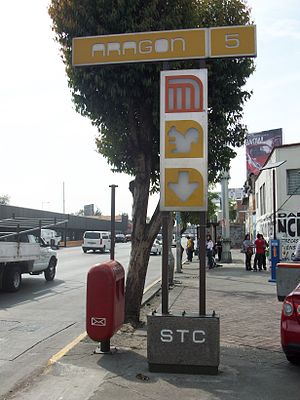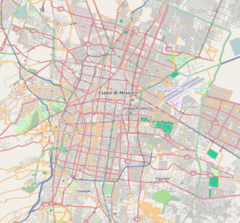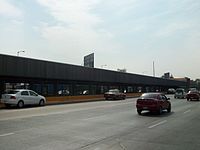railroad.wikisort.org - Station
Aragón (![]() Spanish pronunciation (help·info)) is a Mexico City Metro station within the limits of Gustavo A. Madero and Venustiano Carranza, in Mexico City. It is an at-grade station with one island platform, served by Line 5 (the Yellow Line), between Eduardo Molina and Oceanía stations. Aragón station serves the colonias of Casas Alemán and Simón Bolívar. The station is named after the San Juan de Aragón Park, and its pictogram represents the silhouette of a squirrel. Aragón station was opened on 19 December 1981, on the first day of the Consulado–Pantitlán service. In 2019, the station had an average daily ridership of 7,547 passengers, making it the 172nd busiest station in the network and the eighth busiest of the line.
Spanish pronunciation (help·info)) is a Mexico City Metro station within the limits of Gustavo A. Madero and Venustiano Carranza, in Mexico City. It is an at-grade station with one island platform, served by Line 5 (the Yellow Line), between Eduardo Molina and Oceanía stations. Aragón station serves the colonias of Casas Alemán and Simón Bolívar. The station is named after the San Juan de Aragón Park, and its pictogram represents the silhouette of a squirrel. Aragón station was opened on 19 December 1981, on the first day of the Consulado–Pantitlán service. In 2019, the station had an average daily ridership of 7,547 passengers, making it the 172nd busiest station in the network and the eighth busiest of the line.
| STC rapid transit | ||||||||||||||||||||||||||||||||||||||||||||||||||||||||||||||||||||||||||||||||||||||||||||||||||||||||||
 Station sign, 2012 | ||||||||||||||||||||||||||||||||||||||||||||||||||||||||||||||||||||||||||||||||||||||||||||||||||||||||||
| General information | ||||||||||||||||||||||||||||||||||||||||||||||||||||||||||||||||||||||||||||||||||||||||||||||||||||||||||
| Location | Río Consulado Avenue Gustavo A. Madero and Venustiano Carranza, Mexico City Mexico | |||||||||||||||||||||||||||||||||||||||||||||||||||||||||||||||||||||||||||||||||||||||||||||||||||||||||
| Coordinates | 19°27′04″N 99°05′45″W | |||||||||||||||||||||||||||||||||||||||||||||||||||||||||||||||||||||||||||||||||||||||||||||||||||||||||
| Operated by | Sistema de Transporte Colectivo (STC) | |||||||||||||||||||||||||||||||||||||||||||||||||||||||||||||||||||||||||||||||||||||||||||||||||||||||||
| Line(s) | ||||||||||||||||||||||||||||||||||||||||||||||||||||||||||||||||||||||||||||||||||||||||||||||||||||||||||
| Platforms | 1 island platform | |||||||||||||||||||||||||||||||||||||||||||||||||||||||||||||||||||||||||||||||||||||||||||||||||||||||||
| Tracks | 2 | |||||||||||||||||||||||||||||||||||||||||||||||||||||||||||||||||||||||||||||||||||||||||||||||||||||||||
| Connections |
| |||||||||||||||||||||||||||||||||||||||||||||||||||||||||||||||||||||||||||||||||||||||||||||||||||||||||
| Construction | ||||||||||||||||||||||||||||||||||||||||||||||||||||||||||||||||||||||||||||||||||||||||||||||||||||||||||
| Structure type | At grade | |||||||||||||||||||||||||||||||||||||||||||||||||||||||||||||||||||||||||||||||||||||||||||||||||||||||||
| Other information | ||||||||||||||||||||||||||||||||||||||||||||||||||||||||||||||||||||||||||||||||||||||||||||||||||||||||||
| Status | In service | |||||||||||||||||||||||||||||||||||||||||||||||||||||||||||||||||||||||||||||||||||||||||||||||||||||||||
| History | ||||||||||||||||||||||||||||||||||||||||||||||||||||||||||||||||||||||||||||||||||||||||||||||||||||||||||
| Opened | 19 December 1981 | |||||||||||||||||||||||||||||||||||||||||||||||||||||||||||||||||||||||||||||||||||||||||||||||||||||||||
| Key dates | ||||||||||||||||||||||||||||||||||||||||||||||||||||||||||||||||||||||||||||||||||||||||||||||||||||||||||
| 23 April 2020 | Temporarily closed | |||||||||||||||||||||||||||||||||||||||||||||||||||||||||||||||||||||||||||||||||||||||||||||||||||||||||
| 15 June 2020 | Reopened | |||||||||||||||||||||||||||||||||||||||||||||||||||||||||||||||||||||||||||||||||||||||||||||||||||||||||
| Passengers | ||||||||||||||||||||||||||||||||||||||||||||||||||||||||||||||||||||||||||||||||||||||||||||||||||||||||||
| 2021 | 1,605,655[1] | |||||||||||||||||||||||||||||||||||||||||||||||||||||||||||||||||||||||||||||||||||||||||||||||||||||||||
| Rank | 153/195[1] | |||||||||||||||||||||||||||||||||||||||||||||||||||||||||||||||||||||||||||||||||||||||||||||||||||||||||
| Services | ||||||||||||||||||||||||||||||||||||||||||||||||||||||||||||||||||||||||||||||||||||||||||||||||||||||||||
| ||||||||||||||||||||||||||||||||||||||||||||||||||||||||||||||||||||||||||||||||||||||||||||||||||||||||||
| ||||||||||||||||||||||||||||||||||||||||||||||||||||||||||||||||||||||||||||||||||||||||||||||||||||||||||
| Location | ||||||||||||||||||||||||||||||||||||||||||||||||||||||||||||||||||||||||||||||||||||||||||||||||||||||||||
 Location within Mexico City | ||||||||||||||||||||||||||||||||||||||||||||||||||||||||||||||||||||||||||||||||||||||||||||||||||||||||||
 | ||||||||||||||||||||||||||||||||||||||||||||||||||||||||||||||||||||||||||||||||||||||||||||||||||||||||||
| Area map | ||||||||||||||||||||||||||||||||||||||||||||||||||||||||||||||||||||||||||||||||||||||||||||||||||||||||||
Location

Aragón is a metro station located on Río Consulado Avenue, in northeastern Mexico City.[2] The station serves the colonias (Mexican Spanish for "neighborhoods") of Casas Alemán, in Gustavo A. Madero,[3] and Simón Bolívar, in Venustiano Carranza.[4] Within the system, the station lies between Eduardo Molina and Oceanía stations.[2] The area is serviced by Route 200 of the Red de Transporte de Pasajeros network[5] and by Route 20-B of the city's public bus system.[6]
Exits
There are two exits:[2]
- North: Río Consulado Avenue and Dólares Street, Casas Alemán, Gustavo A. Madero.
- South: Río Consulado Avenue and Peniques Street, Simón Bolívar, Venustiano Carranza.
History and construction
Line 5 of the Mexico City Metro was built by Cometro, a subsidiary of Empresas ICA,[7] and its first section was opened on 19 December 1981, operating from Pantitlán to Consulado stations.[8] The Aragón–Oceanía interstation track has a slope caused by subsidence;[9] the section is 1,219 meters (3,999 ft) long.[10] The Aragón–Eduardo Molina section measures 860 meters (2,820 ft).[10] Aragón is located at grade;[11] the station's pictogram represents a squirrel,[2] and the station is named after San Juan de Aragón Park, a public park and zoo in Gustavo A. Madero,[12] because it was the closest station when it was built.[13]
Incidents
After the 2015 Oceanía station train crash, Aragón station was temporarily closed for repairs.[14] From 23 April to 15 June 2020, the station was temporarily closed due to the COVID-19 pandemic in Mexico.[15][16]
Ridership
According to the data provided by the authorities, between 2011 and 2021, commuters averaged between 3,900 and 8,600 daily entrances. In 2019, before the impact of the COVID-19 pandemic on public transport, the station's ridership totaled 2,754,754 passengers,[17] which was an increase of 21,253 passengers compared to 2018.[18] In the same year, Aragón was the 172nd busiest station of the system's 195 stations, and it was the line's 8th busiest.[17]
| Annual passenger ridership | |||||
|---|---|---|---|---|---|
| Year | Ridership | Average daily | Rank | % change | Ref. |
| 2021 | 1,605,655 | 4,399 | 153/195 | +11.99% | [1] |
| 2020 | 1,433,746 | 3,917 | 174/195 | −47.95% | [19] |
| 2019 | 2,754,754 | 7,547 | 172/195 | +0.78% | [17] |
| 2018 | 2,733,501 | 7,489 | 171/195 | +4.17% | [18] |
| 2017 | 2,624,161 | 7,189 | 171/195 | +0.17% | [20] |
| 2016 | 2,619,656 | 7,157 | 172/195 | −1.89% | [21] |
| 2015 | 2,669,995 | 7,315 | 159/195 | −1.25% | [22] |
| 2014 | 2,703,820 | 7,407 | 160/195 | −1.06% | [23] |
| 2013 | 2,732,838 | 7,487 | 168/195 | −6.70% | [24] |
| 2012 | 2,929,011 | 8,002 | 151/195 | −6.50% | [25] |
| 2011 | 3,132,506 | 8,582 | 145/175 | – | [26] |
References
- "Afluencia de estación por línea 2021" [Station traffic per line 2021] (in Spanish). Sistema Transporte Colectivo Metro. 2022. Archived from the original on 7 March 2022. Retrieved 7 March 2022.
- "Aragón" (in Spanish). Sistema de Transporte Colectivo Metro. Archived from the original on 5 July 2020. Retrieved 23 July 2020.
- "Colonia Fernando Casas Alemán, Código Postal 07960, Gustavo A. Madero, Distrito Federal" [Fernando Casas Alemán, postal code 07960, Gustavo A. Madero, Mexico City] (in Spanish). Heraldo. Archived from the original on 20 March 2015. Retrieved 29 July 2020.
- "Colonia Simón Bolivar, Código Postal 15410, Venustiano Carranza, Distrito Federal" [Simón Bolívar, postal code 15410, Venustiano Carranza, Mexico City] (in Spanish). Heraldo. Retrieved 15 July 2020.
- "Red de Rutas" [Routes network] (in Spanish). Red de Transporte de Pasajeros. Retrieved 30 October 2021.
- "Red de corredores" [Route network] (in Spanish). Retrieved 30 October 2021.
- "Línea 5, Ciudad de México" [Line 5, Mexico City] (in Spanish). iNGENET Infraestructura. 20 July 2009. Archived from the original on 2 September 2014. Retrieved 15 April 2020.
- "Baia, Baia, Tacubaya... Las estaciones del metro MÁS y MENOS utilizadas en CDMX" [Well, well, well... The MOST and LEAST used stations in Mexico City] (in Spanish). Nacion 321. 4 September 2019. Archived from the original on 15 April 2020. Retrieved 14 April 2020.
- Gómez, Ignacio (11 May 2020). "Estación Oceanía, 'hundida' en la burocracia" [Oceanía Station, 'sunk' in the bureaucracy] (in Spanish). máspormás. Archived from the original on 24 July 2020. Retrieved 29 July 2020.
- "Longitud de estación a estación por línea" [Station-to-station length per line] (in Spanish). Sistema de Transporte Colectivo Metro. Archived from the original on 4 May 2021. Retrieved 12 July 2021.
- "Aragon Metro Station (Mexico City, 1981)". Structurae.net. Archived from the original on 24 July 2020. Retrieved 23 July 2020.
- "Cartelera de actividades: Bosque de San Juan de Aragón" [Activities board: San Juan de Aragón Park] (PDF) (in Spanish). Secretaría del Medio Ambiente de la Ciudad de México. 1 July 2019. Archived (PDF) from the original on 17 August 2020. Retrieved 29 July 2020.
- "Los íconos del metro que merecen una explicación" [Metro icons that deserve an explanation] (in Spanish). MXCity. Archived from the original on 24 July 2020. Retrieved 29 July 2020.
- Alarcón, Rodrigo (5 May 2015). "RTP brindará traslado gratuito de Pantitlán a Eduardo Molina" [Red de Transporte de Pasajeros will provide free service from Pantitlán to Eduardo Molina]. Excélsior. Archived from the original on 30 October 2017. Retrieved 23 August 2020.
- "Cierre temporal de estaciones" [Temporal closure of stations] (PDF) (in Spanish). Sistema Transporte Colectivo Metro. Archived (PDF) from the original on 4 July 2020. Retrieved 25 April 2020.
- Hernández, Eduardo (13 June 2020). "Coronavirus. Este es el plan para reabrir estaciones del Metro, Metrobús y Tren ligero" [Coronavirus. This is the plan to reopen Metro, Metrobús and Light Rail stations]. El Universal (in Spanish). Archived from the original on 4 July 2020. Retrieved 15 June 2020.
- "Afluencia de estación por línea 2019" [Station traffic per line 2019] (in Spanish). Sistema Transporte Colectivo Metro. 2020. Archived from the original on 3 July 2020. Retrieved 3 May 2020.
- "Afluencia de estación por línea 2018" [Station traffic per line 2018] (in Spanish). Sistema Transporte Colectivo Metro. 2019. Archived from the original on 6 June 2019. Retrieved 7 April 2020.
- "Afluencia de estación por línea 2020" [Station traffic per line 2020] (in Spanish). Sistema Transporte Colectivo Metro. 2021. Archived from the original on 21 June 2021. Retrieved 21 June 2021.
- "Afluencia de estación por línea 2017" [Station traffic per line 2017] (in Spanish). Sistema Transporte Colectivo Metro. 2019. Archived from the original on 3 May 2020. Retrieved 3 May 2020.
- "Afluencia de estación por línea 2016" [Station traffic per line 2016] (in Spanish). Sistema Transporte Colectivo Metro. 2017. Archived from the original on 3 May 2020. Retrieved 3 May 2020.
- "Afluencia de estación por línea 2015" [Station traffic per line 2015] (in Spanish). Sistema Transporte Colectivo Metro. 2016. Archived from the original on 3 May 2020. Retrieved 6 May 2020.
- "Afluencia de estación por línea 2014" [Station traffic per line 2014] (in Spanish). Sistema Transporte Colectivo Metro. 2015. Archived from the original on 3 May 2020. Retrieved 6 May 2020.
- "Afluencia de estación por línea 2013" [Station traffic per line 2013] (in Spanish). Sistema Transporte Colectivo Metro. 2014. Archived from the original on 3 May 2020. Retrieved 6 May 2020.
- "Afluencia de estación por línea 2012" [Station traffic per line 2012] (in Spanish). Sistema Transporte Colectivo Metro. 2013. Archived from the original on 3 May 2020. Retrieved 6 May 2020.
- "Afluencia de estación por línea 2011" [Station traffic per line 2011] (in Spanish). Sistema Transporte Colectivo Metro. 2012. Archived from the original on 7 May 2020. Retrieved 6 May 2020.
External links
 Media related to Aragón (station) at Wikimedia Commons
Media related to Aragón (station) at Wikimedia Commons- "Metro Aragón". At the Official Guide to Mexico City.
Другой контент может иметь иную лицензию. Перед использованием материалов сайта WikiSort.org внимательно изучите правила лицензирования конкретных элементов наполнения сайта.
WikiSort.org - проект по пересортировке и дополнению контента Википедии